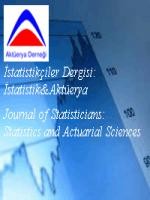Kesirli Polinomlu Lojistik Regresyon Modeli
fonksiyonel ilişkinin olduğu varsayılmaktadır. Doğrusallık varsayımının sağlanmaması modelin yanlış
Anahtar Kelimeler:
Doğrusal olmayan ilişki, Kesirli polinomlar, Sürekli bağımsız değişken.
Logistic Regression Model with Fractional Polynomial
In logistic regression analysis, there is a linearity assumption between the independent and dependentvariables. The violation of linearity assumption leads to wrong final model. When a continuous variable iscategorized to use in a model, the analysis and interpretation of the model may become difficult especiallywith the high number of levels. For these reasons, fractional polynomials are used to determine the functionalstructure of the continuous variables. In this study, the fractional polynomials are examined and applied to areal data set. The results for logistic regression model with an assumption of linearity and logistic regressionmodel with a categorical independent variable were also obtained and discussed.
___
- M. Alikaşifoğlu, E. Erginoz, E.T. Gur, Z. Baltas, B. Beker, A. Arvas, 2001, Factors influencing the duration of exclusive breastfeeding in a group of Turkish women, J Hum Lact, 2001, 17, 220-26.
- D.G. Altman, B. Lausen, W. Sauerbrei, M. Schumacher, 1994, The dangers of using “optimal” cutpoints in the evaluation of prognostic factors, J Natl Cancer Inst, 86, 829-835.
- G. Ambler, P. Royston, 2001, Fractional polynomial model selection procedures: investigation of Type I error rate, J. Statist. Simul. Comput. 69, 89–108.
- Baneshi, M.R., Nakhaee, F., Law, M., 2013, On the Use of Fractional Polynomial Models to Assess Preventive Aspect of Variables: An Example in Prevention of Mortality Following HIV Infection, Int J Prev. Med., 4(4), 414-419.
- C. S. Berkey, R. B. Reed, 1987, A model for describing normal and abnormal growth in early childhood. Hum. Biol., 59, 973-987.
- F. Bolat, S. Uslu, G. Bolat, A. Bülbül, S. Arslan, M. Çelik, S. Cömert., A. Nuhoğlu, 2011, İlk altı ayda anne sütü ile beslenmeye etki eden faktörler. Çocuk Dergisi, 11, 5-13.
- E. W. Count, 1942, A quantitative analysis of growth in certain human skull dimensions. Hum. Biol., 14, 143-165.
- E. W. Count, 1943, Growth patterns of human physique: an approach to kinetic anthropometry. Hum. Biol., 15, 1-32.
- S. Greenland, 1995, Avoiding power loss associated with categorization and ordinaş scores in doseresponse and trend analysis, Epidemiology, 6, 450-454.
- T.J. Hastie, R.J. Tibshirani, 1990, Generalized additive models, New York: Chapman and Hall.
- D. Onay, M. Akman, S. Akdeniz, A. Kacaroglu Vicdan, 2009, Breast-feeding behaviours of the mothers, Pakistan Journal of Nutrition, 8, 1126-31.
- R. Marcus, E. Peritz, E., K.R. Gabriel, 1976, On closed test procedures with special reference to ordered analysis of variance, Biometrika, 76, 655–660.
- P. Royston, P., D.G. Altman, 1994, Regression using fractional polynomials of continuous covariates: parsimonious parametric modelling (with discussion), Applied Statistics, 43, 3, 429–467.
- P. Royston, G. Ambler, W. Sauerbrei, 1999, The use of fractional polynomials to model continuous risk variables in epidemiology, Int J Epidemiol, 28(5):964-974.
- P. Royston, W. Sauerbrei, 2003, Stability of multivariable fractional polynomial models with selection of variables and transformations: a bootstrap investigation, Statistics in Medicine, 22, 639–659.
- P. Royston, W. Sauerbrei, 2004, A new approach to modelling interactions between treatment and continuous covariates in clinical trials by using fractional polynomials, Statististics in Medicine, 23, 2509–2525.
- P. Royston, W. Sauerbrei, 2005, Building multivariable regression models with continuous covariates, with a practical emphasis on fractional polynomials and applications in clinical epidemiology, Methods of Information in Medicine 44, 561–571.
- P. Royston, W. Sauerbrei, 2007, Improving the robustness of fractional polynomial models by preliminary covariate transformation: a pragmatic approach. Computational Statistics & Data Analysis, 51, 4240 – 4253.
- P.Royston, W. Sauerbrei, 2008, Multivariable Model - Building: A Pragmatic Approach to Regression Anaylsis based on Fractional Polynomials for Modelling Continuous Variables, John Wiley and Sons Ltd., England.
- W. Sauerbrei, P. Royston, 1999, Building multivariable prognostic and diagnostic models: transformation of the predictors by using fractional polynomials, Journal of the Royal Statistical Society (Series A), 162, 71–94.
- W. Sauerbrei, P. Royston, 2002, Building multivariable prognostic and diagnostic models: transformation of the predictors by using fractional polynomials, Journal of the Royal Statistical Society (Series A), 165, 399–400.
- W. Sauerbrei, P. Royston, 2006, Multivariate regressiomn model building by using fractional polynomials: Description of SAS, STATA and R programs, Computational Statistics and Data Analysis, 50, 3464– 3485.
- W. Sauerbrei, P. Royston, K. Zapien, 2007, Detecting an interaction between treatment and a continuous covariate: A comparison of two approaches, Computational Statistics & Data Analysis, 51, 4054 – 4063.
- Ç. Şafak, N. Ata, Bebeklerin anne sütü ile beslenme sürelerinin yaşam çözümlemesi ile incelenmesi”, 1. Genç İstatistikçiler Sempozyumu, 10-11 Ekim 2013, Ankara, Türkiye
- E.K. Tunçel, C. Dündar, Y. Pekşen, 2005, Ebelerin anne sütü ile ilgili bilgi ve uygulamalarının değerlendirilmesi, The Medical Journal of Kocatepe, 2005, 6, 43-8.
- H. Ünsal, F. Atlıhan, H. Özkan, Ş. Targan, H. Hassoy, 2005, Toplumda anne sütü verme eğilimi ve buna etki eden faktörler, Çocuk Sağlığı ve Hastalıkları Dergisi, 8, 226-33.
- J. Wingerd, 1970, The relation of growth from birth to two years to sex, parental size and other factors, using Rao's method of the transformed time scale. Hum. Biol., 42, 105-131.
- L. P. Zhao, L.N. Kolonel, 1992, Efficiency loss from categorizing quantitative exposures into qualitative exposures in case-control studies, American Journal of epidemiology, 136, 464-474.
- ISSN: 1308-0539
- Yayın Aralığı: Yılda 2 Sayı
- Başlangıç: 2008
- Yayıncı: Aktüerya Derneği
